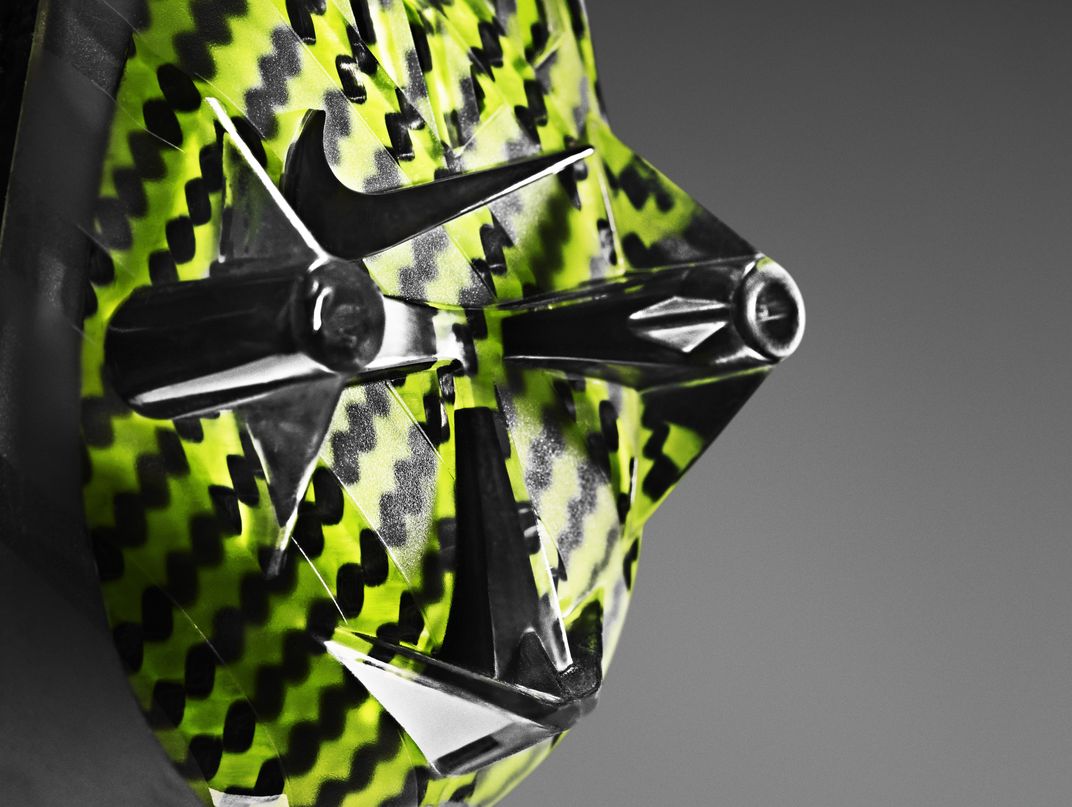This Super Bowl, Players Will Be Wearing 3D Printed Cleats
Nike has designed special shoes that make athletes more explosive from a standing position
:focal(1714x499:1715x500)/https://tf-cmsv2-smithsonianmag-media.s3.amazonaws.com/filer/d0/0c/d00ced3e-7ef1-4de0-831e-e3e34ffba3b8/3d-printed-cleats.jpg)
The obsession with technology in sports has come to this: Nike has designed a shoe to give football players an edge while they’re standing still.
It has both an epic name—the Vapor Carbon Elite Cleat—and cutting-edge pedigree—the key parts were produced on a 3D printer. Fittingly, the cleat will make its debut on the cold and potentially messy turf of New Jersey's MetLife Stadium at this weekend’s Super Bowl. Players from both the Seattle Seahawks and the Denver Broncos will be wearing the new shoe.
Since the mid-1990s, Nike has had a team researching how to make a shoe that maximizes an athlete’s speed. Last year, it released a model called the Vapor Laser Talon. Despite the name, the shoe does not shoot rays of light or extend claws. But it does help football players run faster, thanks largely to increased traction from cleats specially made on a 3D printer.

Digging in
But this is only if athletes are running in a straight line—which, unfortunately, doesn’t happen all that often on a football field. Since the Vapor Laser Talon wasn’t really designed to help players move quickly in all directions, Nike shifted focus, with the goal of making a shoe that would boost any kind of acceleration.
That meant Nike's researchers needed to address what the company calls “zero step.” This is not actually a step, but rather the stance that players take before they begin the drive phase of a sprint—the point at which they will gain the most speed. According to Nike’s research, if players don’t have enough traction as they start to push themselves forward, sideways or backward, they can slip ever so slightly. In fact, designers from Nike analyzed video of athletes propelling through the zero step, and they found that every time, the players would slip and end up losing ground.
“It’s kind of like a moonwalk,” Shane Kohatsu, Nike’s head of innovation explained in an interview with Wired. A player doesn’t really lose much ground, he said, but in a game where leverage and timing can be critical, that little bit can make a big difference. Kohatsu described the observation as the research team’s “big aha moment.”
To take on slippage, Nike embraced a tried-and-true design when it comes to dealing with dirt. They created a cleat that resembles and behaves like a shovel, digging in and staying put. Of course, it’s not Nike’s style to call this a “shovel cleat”—they’ve named it the “V Plate." Four tri-star cleats up near the shoe’s toe propel forward motion, while a variation of the shovel design has been replicated at the sides and back of the shoe to boost lateral motion and backpedaling.
The key to having the Vapor Carbon Elite Cleat ready for the Super Bowl was Nike’s ability to produce the cleats on a 3D printer. What might have taken a few years to create in the past was done in six months.
And so, when you’re watching the game and someone from the Broncos or Seahawks makes a big play, tell your friends it’s because of that player’s zero step. They’ll be so impressed.
Customize this
Here are other examples of how 3D printing is changing sports:
· Shreddin’ it 3D style: Last year, California-based Signal Snowboards used a 3D printer to make a snowboard that was able to hit the slopes. It was printed in carbon powder pieces that were glued together, then reinforced with rods because it was too flimsy. But it managed to glide down a mountain covered with deep Colorado powder, even if it was a bit slower than normal.
· Best seat in the house: Engineers at the Loughborough University Sports Technology Institute in the U.K. have devised a way to create customized seats for wheelchair basketball players. They first used 3D scanning technology to get a detailed reading on how players sat in their chairs, then had 3D printers make seats so customized that they take into account the player’s size, shape and even the nature of his or her disability. All player who tested the wheelchair said they were able to move faster and more easily when they used a custom-made seat.
· This shoe is so me: Designers at New Balance are able to make running shoes completely customized, not only to an athlete’s foot, but also to his or her running motion. First, they put the runner in shoes wired with sensors to determine how the person’s foot interacts with the shoe. From that, they can make a pair of shoes where the orientation, size and number of cleats is based on how the wearer runs. And because it’s so much easier now to print a customized shoe bottom, a runner could one day have a shoe created for how he plans to run a particular race.
· Unfortunately, doctors aren’t known for their penmanship: In what could be a boon to sports medicine, researchers in Australia have developed a device they call a “BioPen,” which, functioning like a 3D printer, would allow doctors to “draw” layers of stem cells to repair damaged bone or cartilage. Those cells would grow into tissue that can speed up the recovery process.
Video bonus: Here is Nike’s take on how its Super Bowl cleats came to be.
Video bonus bonus: Watch how the BioPen “draws” stem cells onto damaged bones.
More from Smithsonian.com
/https://tf-cmsv2-smithsonianmag-media.s3.amazonaws.com/accounts/headshot/randy-rieland-240.png)



/https://tf-cmsv2-smithsonianmag-media.s3.amazonaws.com/accounts/headshot/randy-rieland-240.png)